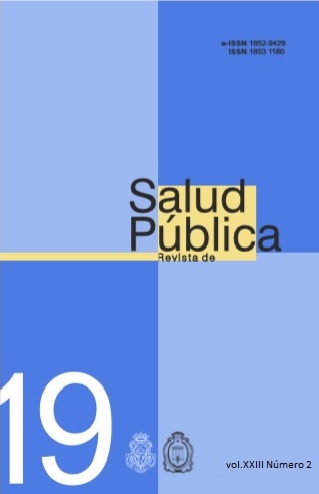Prevalencia de anemia en niñas/os de 6 a 48 meses que concurren a dos CAIF de la ciudad de Salto.
DOI:
https://doi.org/10.31052/1853.1180.v23.n2.21185Palabras clave:
Anemia, niños entre 6 y 48 meses, prevalencia de anemiaResumen
Introducción. La anemia en los niños es un problema de salud pública importante en nuestro país, siendo la anemia por deficiencia de hierro la más frecuente. La frecuencia de anemia en el interior del país es mayor a lo observado en Montevideo. Sin embargo, no existen datos específicos del Departamento de Salto. Objetivos. Determinar la prevalencia de anemia en niños y niñas de 6 a 48 meses que concurren a dos Centros de Atención a la Primera Infancia (CAIF) de la ciudad de Salto y analizar los factores asociados. Metodología. Se determino los niveles de hemoglobina por punción digital en 240 niños de dos CAIF, se relevaron los antecedentes perinatales del carnet del niño/a y datos de ancestralidad por medio de una encuesta a los responsables de los niños. Resultados. La prevalencia de anemia fue de 22,5% en toda la muestra, siendo levemente mayor en el CAIF2 (27,4%) que en el CAIF1(18,4%). La frecuencia de anemia es significativamente menor en los niños que tuvieron lactancia materna exclusiva hasta los 6 meses de edad, mientras que las restantes variables analizadas no presentaron asociación con la anemia. Conclusiones. La disminución observada de la frecuencia de anemia comparada con lo reportado en 2011 sugiere que las políticas de fortificación con hierro de los alimentos y de administración de hierro profiláctico a niños entre 6 y 24 meses ha sido positiva. Adicionalmente, la menor frecuencia de anemia observada en el CAIF1 indica la importancia de la acción coordinada entre los servicios de salud y la sociedad.
Descargas
Referencias
1. WHO. The global prevalence of anaemia in 2011. Geneva: World Health Organization; 2015.
2. Worldwide prevalence of anaemia 1993-2005. Base de datos mundial sobre la anemia de la OMS, Ginebra, de Benoist B et al., eds. Organización Mundial de la Salud. 2008.
3. Ministerio de Salud Pública. Recomendaciones para la prevención y el tratamiento de la deficiencia de hierro. Plan Nacional de Salud Perinatal y de Primera Infancia. MSP. 2014.
4. WHO. Iron deficiency anaemia: assessment, prevention, and control. A guide for programme managers. Geneva, World Health Organization. 2001 (WHO/NHD/01.3).
5. Lozoff B, Smith JB, Kaciroti N, Clark KM, Guevara S, Jimenez E. Functional Significance of Early-Life Iron Deficiency: Outcomes at 25 Years. J Pediatr. 2013; 163(5): 1260-1266.
6. Pala E, Erguven M, Guven S, Erdogan M, Balta T. Psychomotor development in children with iron deficiency and iron-deficiency anemia. Food Nutr Bull. 2010; 31(3):431-5.
7. Thorisdottir AV, Gunnarsdottir I, Palsson GI, Gretarsson SJ, Thorsdottir I. Iron status and developmental scores in 6-year-olds highlights ongoing need to tackle iron deficiency in infants. Acta Paediatr. 2013; 102(9):914-9.
8. Illa. M, Moll. MJ, García. AM, Satriano. R, Ferreira. R, Estefanell. C, Sayagués. B. Estudio de la frecuencia y magnitud del déficit de hierro en niños de 6 a 24 meses de edad, usuarios de los servicios del Ministerio de Salud Pública. Arch. Pediatr. Urug 2008; 79(1): 21-31.
9. Bove. MI, Cerruti. F. Encuesta nacional sobre estado nutricional, prácticas de alimentación y anemia. Montevideo: MSP, MIDES, UNICEF, RUANI; 2011.
10. Machado K, Alcarraz G, Morinico E, Briozzo T, Gutierrez S. Anemia ferropénica en niños menores de un año usuarios de CASMU-IAMPP: prevalencia y factores asociados. Arch. Pediat. Urug. 2017; 88(5): 254-260.
11. Organización Mundial de la Salud. Concentraciones de hemoglobina para diagnosticar la anemia y evaluar su gravedad. Ginebra, Organización Mundial de la Salud. 2011 (WHO/NMH/NHD/MNM/11.1)
12. Organización Mundial de la Salud. Iron defieciency anaemia: assesmment, prevention and control. A guide for programme managers. 2001. WHO/NHD/01.3
13. Ministerio de Salud Pública. Guías para la prevención de la deficiencia de hierro. Programa Nacional de Nutrición, 2008. Disponible en: http://www.msp.gub.uy/uc_1972_1. html
14. Pinasco, P., Fernández, M y Rodríguez, MJ. 2016. Prevalencia de anemia en lactantes de 8 meses afiliados al Centro de Asistencia Médica de Salto en el período 1de setiembre de 2015 al 30 de marzo de 2016. 5tas Jornadas de Pediatría del Litoral. 4 y 5 de noviembre de 2016. Paysandú.
15. Cabella, W., Nathan, M., y Tenenbaum, M. (2013). “Situación de la población afrodescendiente”. En: Calvo, J.J. (comp.). Atlas sociodemográfico y de la desigualdad del Uruguay. Las Necesidades Básicas Insatisfechas a partir de los Censos 2011, INE, UDELAR, MIDES, UNFPA y CSP-OPP. Montevideo: Trilce. ISBN 978-9974-32-616-3.
16. da Luz J, Avila A, Icasuriaga S, Góngora M, Castillo L, Serrón A, Kimura EM, Costa FF, Sans M, y Sonati MF. Frequency and spectrum of hemoglobinopathy mutations in a paediatric population of Uruguay. Genet. Mol. Biol. 2013; 36(3): 316-22
17. da Luz JA, Sans M, Kimura EM, Albuquerque DM, Sonati MF y Costa FF. alpha-thalassemia, HbS, and beta-globin gene cluster haplotypes in two Afro-Uruguayan sub-populations from northern and southern Uruguay. Genet. Mol. Biol. 2006; 29(4): 595-600.
Descargas
Publicado
Número
Sección
Licencia
Derechos de autor 2019 Escuela de Salud Pública y Ambiente. Facultad de Ciencias Médicas. Universidad Nacional de Córdoba

Esta obra está bajo una licencia internacional Creative Commons Atribución-NoComercial 4.0.
Aquellos autores/as que tengan publicaciones con esta revista, aceptan los términos siguientes:
Se permite la generación de obras derivadas siempre que no se haga con fines comerciales.
Tampoco se puede utilizar la obra original con fines comerciales.
Se permite y recomienda a los autores/as difundir su obra a través de redes sociales profesionales o en su página web, luego del proceso de publicación a los fines de aumentar la visibilidad del su investigación.







